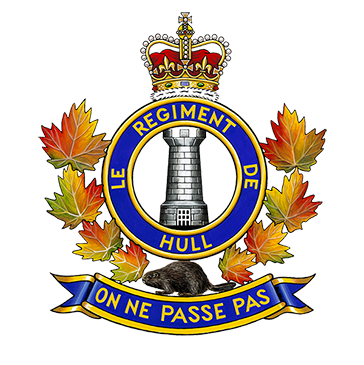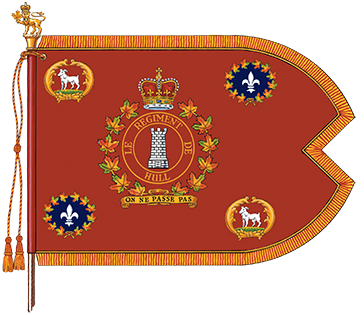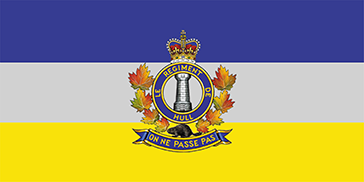Le Régiment de Hull (RCAC)
The official lineage of Le Régiment de Hull (RCAC) armour regiment.

Badge
Description
A tower Argent within an annulus Azure edged and inscribed LE RÉGIMENT DE HULL in letters Or, ensigned by the Royal Crown, flanked on either side by maple leaves in autumnal tints and resting upon a beaver all proper, the whole set upon a scroll Azure edged and inscribed ON NE PASSE PAS in letters Or.
Symbolism
The maple leaves and beaver represent service to Canada, and the Crown, service to the Sovereign. "LE REGIMENT DE HULL" is a form of the regimental title and "ON NE PASSE PAS" is the motto of the regiment. The tower symbolizes the theme of the regimental motto.
Motto
ON NE PASSE PAS (They shall not pass)
March
La Marche de la victoire
Guidon

Camp flag

Battle honours
South-West Asia
AFGHANISTAN
Lineage
This Reserve Force regiment originated in Hull, Quebec on 7 August 1914, when a "City Corps Battalion of Infantry, with headquarters at Hull" was authorized to be formed.Footnote 1 It was designated '70th Regiment' on 15 October 1914;Footnote 2 'The Hull Regiment' on 12 March 1920;Footnote 3 'Le Régiment de Hull' on 1 March 1923;Footnote 4 '2nd (Reserve) Battalion, Le Régiment de Hull' on 7 November 1940;Footnote 5 'Le Régiment de Hull' on 18 September 1945;Footnote 6 '21st Armoured Regiment (Régiment de Hull), RCAC' on 1 April 1946;Footnote 7 'Le Régiment de Hull (21st Armoured Regiment)' on 4 February 1949;Footnote 8 and 'Le Régiment de Hull (RCAC)' on 19 May 1958.Footnote 9
Notes :
Upon redesignation as The Hull Regiment on 12 March 1920 (see above), it was organized as a two battalion regiment with the 1st Battalion (230th Battalion, CEF) on the Non Permanent Active Militia order of battle and the 2nd Battalion (no CEF designation) on the Reserve order of battle. The reserve units were disbanded on 14 December 1936 (GO 3/37).
The Hull Regiment was disbanded for the purpose of reorganization on 1 June 1920 and reorganized the same day (GO 136/20). This change was administrative and does not affect the lineage of the regiment.
Le Régiment de Hull was disbanded for the purpose of reorganization on 1 April 1931 and reorganized the same day (GO 46/31). This change was administrative and does not affect the lineage of the regiment
Perpetuations
'230th "Overseas" Canadian Forestry Battalion, CEF'
Headquarters Location
Gatineau, Quebec
Operational history
The First World War
The 230th Battalion was authorized on 15 July 1916 as the '230th "Overseas" Battalion, CEF'.Footnote 10 It was redesignated the '230th "Overseas" Canadian Forestry Battalion, CEF" on 25 October 1916,Footnote 11 and embarked for Britain in three drafts on 3 May, 2 June and 25 June 1917.Footnote 12 Its personnel were absorbed by the 'Canadian Forestry Corps, CEF' in March 1917.Footnote 13 The battalion was disbanded on 27 July 1918.Footnote 14
The Second World War
Details from the regiment were called out on service on 26 August 1939 and then placed on active service on 1 September 1939 under the designation 'Le Régiment de Hull, CASF (Details)', for local protection duties.Footnote 15 The details called out on active service were disbanded on 31 December 1940.Footnote 16 The regiment subsequently mobilized the '1st Battalion, Le Régiment de Hull, CASF' for active service on 29 July 1941.Footnote 17 It was redesignated and '4th Canadian Infantry Training Battalion, Type B (Le Régiment de Hull), CASF' on 1 November 1944.Footnote 18 It served in Canada in a home defence role as part of Pacific Command;Footnote 19 and took part in the expedition to Kiska, Alaska as a component of the 13th Canadian Infantry Brigade Group, serving there from 16 August 1943 to 6 January 1944.Footnote 20 It embarked for Britain on 25 May 1944.Footnote 21 The battalion served in England until disbanded on 18 September 1945.Footnote 22
South-West Asia
From 2002 to 2014, Le Régiment de Hull reinforced various CAF units deployed to Afghanistan.Footnote 23
Page details
- Date modified: